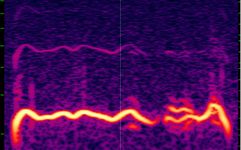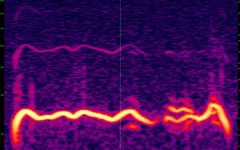Difference between revisions of "Spectrograms of the call of the Common Swift"
Martinwguy (talk | contribs) |
Martinwguy (talk | contribs) |
||
| Line 3: | Line 3: | ||
=The polyphonic call of the Common Swift= | =The polyphonic call of the Common Swift= | ||
| − | + | The last few years, I've helped fallen Common Swifts grow and fly again. | |
| − | + | In some of the 45-minute breaks I had between feeding them, I recorded some of their chirping, | |
| − | + | hoping to learn their language. | |
| − | + | Instead I found another marvel: they sing more than one note at a time. | |
| − | |||
| − | |||
| − | |||
| − | Instead I found another marvel: they | ||
==Multiple notes or turbo vibrato== | ==Multiple notes or turbo vibrato== | ||
| − | Here's the third | + | Here's the third of a ten-second sequence of fourteen trills from Rondone #3 of 2018. |
{{Spectrogallery|2018-05 Rondone 2018-05 n3 polyphonic call 0.4s}} | {{Spectrogallery|2018-05 Rondone 2018-05 n3 polyphonic call 0.4s}} | ||
| − | and | + | The bottom of the spectrogram represents 3386Hz, the top 16106Hz and the clip lasts 0.4 seconds. |
| + | The lines are the main song ranging from 4000 to 4500Hz and the fainter line above is the first harmonic | ||
| + | of that tone, from 8000 to 900Hz but what are those extra lines. 500Hz and 100Hz above the fundamental tone? | ||
| + | |||
| + | Here it is slowed down by eight times, which drops it by three octaves so that we humans can hear it better | ||
and slows it down that our slow brains can follow it. | and slows it down that our slow brains can follow it. | ||
| + | They're not harmonics of anything; it's a chord of two notes, with another two fainter ones above and below that. | ||
{{Spectrogallery|2018-05 Rondone 2018-05 n3 polyphonic call slowed down 8 times}} | {{Spectrogallery|2018-05 Rondone 2018-05 n3 polyphonic call slowed down 8 times}} | ||
| − | + | The extra notes look equally spaced in frequency. At the bottom of the first trough | |
| − | |||
| − | |||
| − | |||
| − | |||
| − | |||
| − | |||
| − | |||
| − | The extra notes look equally spaced in frequency | ||
| − | |||
about three quarters of the way through, the melody is about 4580Hz, | about three quarters of the way through, the melody is about 4580Hz, | ||
the line above it at 5050Hz and the one above that at 5600Hz, | the line above it at 5050Hz and the one above that at 5600Hz, | ||
| − | differences of 470Hz and of 550Hz | + | differences of about 470Hz and of 550Hz, so it may be that the |
| + | swift is frequency-modulating its call, putting a vibrato on the main tone to vary the frequency 500 times a second. | ||
| − | + | This *still* means it has two voices. The main voice is about 5000Hz and the frequency modulation (if that's what it is) | |
| − | + | is at about 500Hz which, to them, is more like growling than singing. | |
| − | In human terms, it would mean being able to | + | In human voice terms, it would mean being able to wobble the frequency of a sung note fifty times a second. |
At a distance, a 500Hz raspberry would be inaudible to a swift, especially at a distance, | At a distance, a 500Hz raspberry would be inaudible to a swift, especially at a distance, | ||
| − | but by frequency-modulating the main vocal chord | + | but by frequency-modulating the main vocal chord, |
| − | the extra sounds they | + | the extra sounds it creates would be within the range at which they hear best and would also be heard well at a distance. |
Revision as of 12:55, 26 February 2019
The polyphonic call of the Common Swift
The last few years, I've helped fallen Common Swifts grow and fly again. In some of the 45-minute breaks I had between feeding them, I recorded some of their chirping, hoping to learn their language.
Instead I found another marvel: they sing more than one note at a time.
Multiple notes or turbo vibrato
Here's the third of a ten-second sequence of fourteen trills from Rondone #3 of 2018.
The bottom of the spectrogram represents 3386Hz, the top 16106Hz and the clip lasts 0.4 seconds. The lines are the main song ranging from 4000 to 4500Hz and the fainter line above is the first harmonic of that tone, from 8000 to 900Hz but what are those extra lines. 500Hz and 100Hz above the fundamental tone?
Here it is slowed down by eight times, which drops it by three octaves so that we humans can hear it better and slows it down that our slow brains can follow it. They're not harmonics of anything; it's a chord of two notes, with another two fainter ones above and below that.
The extra notes look equally spaced in frequency. At the bottom of the first trough about three quarters of the way through, the melody is about 4580Hz, the line above it at 5050Hz and the one above that at 5600Hz, differences of about 470Hz and of 550Hz, so it may be that the swift is frequency-modulating its call, putting a vibrato on the main tone to vary the frequency 500 times a second.
This *still* means it has two voices. The main voice is about 5000Hz and the frequency modulation (if that's what it is) is at about 500Hz which, to them, is more like growling than singing. In human voice terms, it would mean being able to wobble the frequency of a sung note fifty times a second.
At a distance, a 500Hz raspberry would be inaudible to a swift, especially at a distance, but by frequency-modulating the main vocal chord, the extra sounds it creates would be within the range at which they hear best and would also be heard well at a distance.

